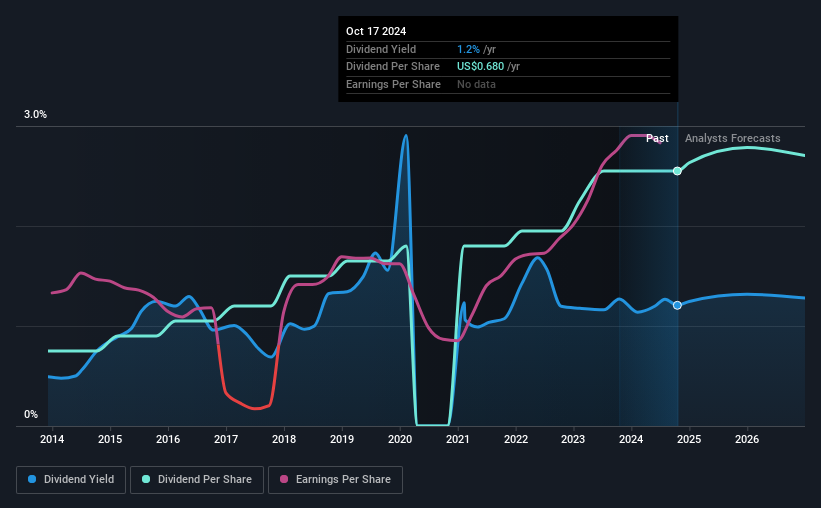Terex (NYSE:TEX) Has Affirmed Its Dividend Of $0.17
Terex Corporation (NYSE:TEX) will pay a dividend of $0.17 on the 19th of December. This means the annual payment will be 1.2% of the current stock price, which is lower than the industry average.
Check out our latest analysis for Terex
Terex's Projected Earnings Seem Likely To Cover Future Distributions
While yield is important, another factor to consider about a company's dividend is whether the current payout levels are feasible. However, prior to this announcement, Terex's dividend was comfortably covered by both cash flow and earnings. This means that most of what the business earns is being used to help it grow.
EPS is set to fall by 19.1% over the next 12 months. Assuming the dividend continues along recent trends, we believe the payout ratio could be 13%, which we are pretty comfortable with and we think is feasible on an earnings basis.

Dividend Volatility
Although the company has a long dividend history, it has been cut at least once in the last 10 years. The dividend has gone from an annual total of $0.20 in 2014 to the most recent total annual payment of $0.68. This means that it has been growing its distributions at 13% per annum over that time. Dividends have grown rapidly over this time, but with cuts in the past we are not certain that this stock will be a reliable source of income in the future.
The Dividend Looks Likely To Grow
With a relatively unstable dividend, it's even more important to evaluate if earnings per share is growing, which could point to a growing dividend in the future. It's encouraging to see that Terex has been growing its earnings per share at 19% a year over the past five years. A low payout ratio and decent growth suggests that the company is reinvesting well, and it also has plenty of room to increase the dividend over time.
Terex Looks Like A Great Dividend Stock
In summary, it is good to see that the dividend is staying consistent, and we don't think there is any reason to suspect this might change over the medium term. The earnings easily cover the company's distributions, and the company is generating plenty of cash. However, it is worth noting that the earnings are expected to fall over the next year, which may not change the long term outlook, but could affect the dividend payment in the next 12 months. Taking this all into consideration, this looks like it could be a good dividend opportunity.
It's important to note that companies having a consistent dividend policy will generate greater investor confidence than those having an erratic one. Meanwhile, despite the importance of dividend payments, they are not the only factors our readers should know when assessing a company. As an example, we've identified 1 warning sign for Terex that you should be aware of before investing. If you are a dividend investor, you might also want to look at our curated list of high yield dividend stocks.
Have feedback on this article? Concerned about the content? Get in touch with us directly. Alternatively, email editorial-team (at) simplywallst.com.
This article by Simply Wall St is general in nature. We provide commentary based on historical data and analyst forecasts only using an unbiased methodology and our articles are not intended to be financial advice. It does not constitute a recommendation to buy or sell any stock, and does not take account of your objectives, or your financial situation. We aim to bring you long-term focused analysis driven by fundamental data. Note that our analysis may not factor in the latest price-sensitive company announcements or qualitative material. Simply Wall St has no position in any stocks mentioned.
 Index Options
Index Options CME Group
CME Group Nasdaq
Nasdaq Cboe
Cboe TradingView
TradingView Wall Street Journal
Wall Street Journal